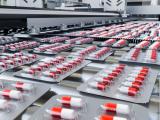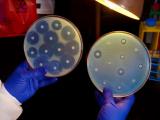A new analysis of how the major players in the antibiotic market are responding to the antimicrobial resistance (AMR) threat suggests that interest in antibiotic research and development is growing and that companies are making greater efforts to curb the environmental impact of antibiotic manufacturing.
But efforts to make antibiotics more accessible to people in the countries where they are desperately needed are lagging.
Those are the conclusions of the Access to Medicine Foundation's 2021 AMR Benchmark, published today. The third iteration of the report evaluates 17 companies that produce a combined total of 801 antibacterial products at 1,057 manufacturing sites. The companies include 8 large research-based pharmaceutical companies and 9 generic medicine manufacturers.
"This report gives a reality check on how the biggest players in the anti-infectives market are responding to the drug resistance and access challenges we face," Benchmark co-author and Access to Medicine Foundation research program manager Fatema Rafiqi, PhD, said during a webinar this morning. "While there are bright spots of progress…the pace of change still has yet to match the scale of the AMR challenge."
More products in the pipeline
One of the bright spots highlighted in the report is an increase in the number of antibacterial projects being pursued by the companies. Although the poor return on investment with new antibiotics has led many companies to abandon antibiotic development in recent years, resulting in a small pipeline of new products, the 2021 Benchmark finds that the companies are becoming more engaged in antibiotic research and development (R&D).
The pipeline is still small, but among the eight large research-based companies, the Benchmark identified 92 projects targeting infections caused by priority pathogens, up from 77 in 2020. Those include 33 projects targeting the highest priority pathogens identified by the World Health Organization and the US Centers for Disease Control and Prevention, up from 25 in 2020. Leading the way are GSK, with 31 R&D projects (half of which are vaccines), and Pfizer, which has 13 projects overall and the most in the late stages of development.
Among the products in development that are highlighted in the report are Pfizer's new antifungal candidate (fosmanogepix), which targets the highly resistant Candida auris, GSK's antibiotic for Neisseria gonorrhoeae (gepotidacin), and Johnson & Johnson's Escherichia coli vaccine (ExPEC9V).
In addition, companies are making plans to ensure that people in countries with high disease burdens will have access to these new products and that the products will be used responsibly. Eighteen of the 20 medicine products in phase 2 development or beyond have access and stewardship plans in place, and all 11 late-stage vaccine projects have access plans. In the first AMR Benchmark report, published in 2018, only a handful of projects were covered by access and stewardship plans.
In addition, Rafiqi noted, the report found that more companies are addressing the overselling of antibiotics by decoupling bonuses for sales agents from the amount of antibiotics they sell.
The Benchmark also shows that pharmaceutical companies are doing more to limit the discharge of antibiotic waste from manufacturing plants into the environment. Ten of the 17 companies now say they require their suppliers to limit the discharge of active pharmaceutical ingredients into the environment, up from 3 of 13 in 2018.
Among the companies leading the way on these efforts is GSK, which reported that 37 out of 39 of its suppliers' sites are now compliant with set limits. Overall, however, only 5% of 870 antibiotic manufacturing sites were found to be compliant with discharge limits.
The discharge of antibiotic residues into the environment—where they can exert selective pressure and promote the emergence of resistance genes—has been a notable problem in India, which is home to many antibiotic manufacturing plants. Studies have found high concentrations of antibiotics, and a high abundance of antibiotic resistance genes, in water from sources in and around Hyderabad, a major pharmaceutical manufacturing hub.
"The repercussions posed by antibiotic discharge into the environment is clear, and it begs the need for responsible production," Rafiqi said.
Access in LMICs remains limited
When it comes to the current portfolio of antibacterial products sold by these companies, however, the report found that low- and middle-income countries (LMICs) still have limited access to these products, and the companies aren't doing as much as they could to boost access.
Of the 166 products assessed, only 54 are covered by a strategy that could make these drugs more accessible in LMICs, such as equitable pricing arrangements, technology transfers, and voluntary licensing agreements.
The report also found that only six on-patent medicines had been filed for registration—the first step in making a medical product available in a country—in 10 or more of the 102 LMICs included in the analysis.
Although public health messaging has focused on the dangers of irresponsible antibiotic use, the lack of access to antibiotics and antifungals in LMICs is an equally important issue, because these countries have the highest burden of infectious disease and the highest rates of antibiotic resistance. An estimated 5.7 million people, mainly those living in LMICs, die each year from lack of access to antibiotics.
Furthermore, the report notes, when the right antibiotics aren't available, healthcare providers have to resort to using suboptimal treatments, which gives bacterial pathogens more opportunities to develop resistance.
Pharmaceutical companies need to use the full range of access strategies to get their products into LMICs and reach the world's most vulnerable patients, the report concludes.
"Current industry access strategies do not go far enough, and many of the world's most vulnerable patients are still not receiving the life-saving medicines they need," the report states. "Future strategies need to increase in quality and reach, in order to cover a wider range of countries, people, and treatments—with the fragments of different strategies coming together to form a more comprehensive picture."

























